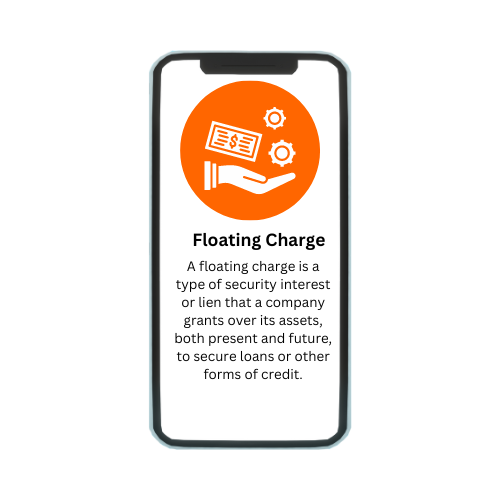A floating charge is a crucial concept in finance and business law, serving as a flexible form of security interest or lien over a company’s assets, both current and future. Unlike a fixed charge that applies to specific, identifiable assets such as land or buildings, a floating charge covers assets that regularly change, such as inventory or accounts receivable. This type of charge allows businesses to use their assets as collateral for loans while continuing to operate and modify their asset base. It provides lenders with security and the potential to convert the floating charge into a fixed charge in the event of default, ensuring they can recover their investment. Understanding the nuances of floating charges is essential for both businesses seeking financing and lenders managing risk in lending transactions.
What Is a Floating Charge?
A floating charge is a type of security interest or lien that a company grants over its assets, both present and future, to secure loans or other forms of credit. Unlike a fixed charge, which is tied to specific, identifiable assets like land or buildings, a floating charge covers assets that are changing and fluctuating, such as inventory, accounts receivable, or other types of movable property. The assets under a floating charge can be used by the company in its ordinary course of business, which allows the company to continue operating and generating revenue. This flexibility is beneficial for businesses as it provides them with the ability to use their assets to secure financing without restricting their day-to-day operations. However, in the event of default or insolvency, the floating charge “crystallizes” into a fixed charge, allowing the lender to take control of the assets covered by the charge to recover their investment. Floating charges are typically created through legal agreements, such as debentures or security agreements, and must be registered to be valid and enforceable.
Why Is a Floating Charge Important?
A floating charge is important because it provides businesses with a flexible means of securing financing while allowing them to continue operating and managing their assets. Unlike fixed charges, which apply to specific, immovable assets like land or buildings, a floating charge covers a broader range of assets that are essential for a company’s day-to-day operations, such as inventory and accounts receivable. This flexibility is crucial for businesses that need working capital to grow or manage their cash flow effectively. By granting a floating charge, businesses can use their changing assets as collateral without restricting their ability to trade, borrow, or invest. This arrangement benefits both the company and the lender: the company gains access to necessary funds, while the lender gains security and the potential to convert the floating charge into a fixed charge if the company defaults on its obligations. Overall, a floating charge strikes a balance between providing businesses with the flexibility they need to operate and ensuring lenders have adequate security to protect their investments.
Characteristics of Floating Charges
The key characteristics of floating charges include:
- Continuity: A floating charge remains effective even as the assets subject to it change over time. This means that as a company sells inventory, collects receivables, or otherwise changes its asset composition, the floating charge remains in place.
- Non-possessory: Unlike a fixed charge, where the lender may take physical possession of the assets upon default, a floating charge does not grant the lender immediate possession of the assets. The company retains the right to use, sell, or otherwise dispose of the assets covered by the floating charge until specific conditions (such as default) occur.
- Convertible: In the event of default, a floating charge can convert into a fixed charge. This conversion typically occurs when the floating charge “crystallizes,” meaning it becomes fixed and attaches to specific, identifiable assets. This provides the lender with greater security and control over the assets to recover their investment.
- Scope: Floating charges cover a wide range of assets, including inventory, accounts receivable, and other movable property. This broad scope allows businesses to use a variety of assets as collateral for loans, providing flexibility in securing financing.
- Creation: Floating charges are typically created through legal documents such as debentures or security agreements. These agreements outline the terms and conditions under which the floating charge is granted, including the rights and obligations of both the company and the lender.
- Registration: To be valid and enforceable, floating charges must be registered with the appropriate authorities, such as the Companies House in the UK. Registration ensures that the charge is publicly recorded and protects the lender’s priority over other creditors in case of insolvency.
- Flexibility for Businesses: Floating charges allow businesses to use their assets as collateral without restricting their ability to trade, invest, or manage their assets. This flexibility is crucial for companies that need working capital to fund growth or manage their cash flow effectively.
Example of Floating Charges
An example of a floating charge can be seen in a manufacturing company, ABC Ltd., that grants a floating charge over its inventory and accounts receivable to secure a loan from Bank XYZ. ABC Ltd. regularly sells its products and collects payments from customers, causing its inventory and accounts receivable to fluctuate. The floating charge allows ABC Ltd. to use these assets as collateral for the loan while continuing its business operations. Bank XYZ, as the lender, benefits from the floating charge because it provides security over a broad range of assets, allowing ABC Ltd. to maintain flexibility in managing its working capital and cash flow. If ABC Ltd. defaults on the loan, the floating charge would crystallize into a fixed charge, enabling Bank XYZ to take possession of and sell the specific assets covered by the charge to recover its investment. This example illustrates how floating charges provide businesses with the ability to secure financing using their changing assets, while lenders maintain security and the potential for recovery in case of default.
Advantages of Using a Floating Charge for Lenders
Lenders benefit from floating charges in several ways:
- Flexibility: Floating charges provide lenders with flexibility as they cover a wide range of assets, including inventory, accounts receivable, and other movable property. This flexibility allows lenders to secure their loans without restricting the borrower’s ability to operate and manage their assets.
- Continued Operations: Unlike fixed charges that restrict a borrower’s ability to deal with assets, floating charges allow businesses to continue trading and using their assets as usual. This ensures that the borrower can generate revenue, which is beneficial for both parties.
- Priority in Insolvency: In the event of the borrower’s insolvency or default, floating charges typically convert into fixed charges. This conversion gives lenders priority over other unsecured creditors in recovering their investment from the specific assets covered by the charge.
- Security: Floating charges provide lenders with security over a broader range of assets compared to fixed charges. This enhances the lender’s ability to recover their investment, as they have a claim on various types of assets that the borrower uses to operate their business.
- Potential for Conversion: Floating charges have the potential to convert into fixed charges upon default. This conversion provides lenders with a more secure position, allowing them to take possession of and sell specific assets to recover the loan amount.
How Is a Floating Charge Created?
A floating charge is typically created through a legal document, such as a debenture or a security agreement, between a borrower (often a company) and a lender. The document outlines the terms and conditions under which the floating charge is granted. It identifies the assets over which the floating charge will apply, which often include inventory, accounts receivable, and other movable property. Unlike a fixed charge, which attaches to specific, identifiable assets, a floating charge covers assets that are subject to change over time as the company continues its business operations. The borrower retains the right to use, sell, or otherwise dispose of these assets in the normal course of business. However, the lender gains a security interest in these assets, providing them with the right to convert the floating charge into a fixed charge in certain circumstances, such as default on loan repayments. To be legally valid and enforceable, the floating charge must be registered with the appropriate authorities, such as the Companies House in the UK. Registration ensures that the charge is publicly recorded and gives the lender priority over other creditors in case of the borrower’s insolvency. Overall, creating a floating charge involves a legal agreement that provides both flexibility for the borrower and security for the lender, making it a valuable tool in commercial financing.
Floating Charge Vs. Fixed Charge
Floating charges and fixed charges are both types of security interests used by lenders to secure loans or credit facilities, but they differ in several key aspects:
- Nature of Assets: A fixed charge applies to specific, identifiable assets that are usually immovable and of a permanent nature, such as land, buildings, or machinery. The lender has a proprietary interest in these assets and may take possession of them upon default to recover their investment.
- In contrast, a floating charge covers a broader range of assets that are subject to change over time, such as inventory, accounts receivable, and other movable property. The assets under a floating charge can be used and traded by the borrower in the ordinary course of business.
- Possession: With a fixed charge, the lender typically takes immediate possession of the specified assets upon default, effectively removing the borrower’s ability to use or dispose of them.
Conclusion
In conclusion, floating charges play a crucial role in modern finance by providing businesses with a flexible means of securing loans while allowing them to maintain operational freedom. Unlike fixed charges, which apply to specific, immovable assets, floating charges cover a dynamic range of assets that can change over time. This flexibility allows businesses to use their current and future assets, such as inventory and accounts receivable, as collateral without hindering their day-to-day operations. For lenders, floating charges provide a broader security interest that can convert into a fixed charge in the event of default, enhancing their ability to recover their investment. By understanding the characteristics, creation process, and advantages of floating charges, both borrowers and lenders can effectively navigate the complexities of commercial financing while balancing the needs for flexibility and security. Overall, floating charges serve as a pivotal tool in facilitating economic growth and stability by supporting businesses in accessing the capital they need to thrive.








